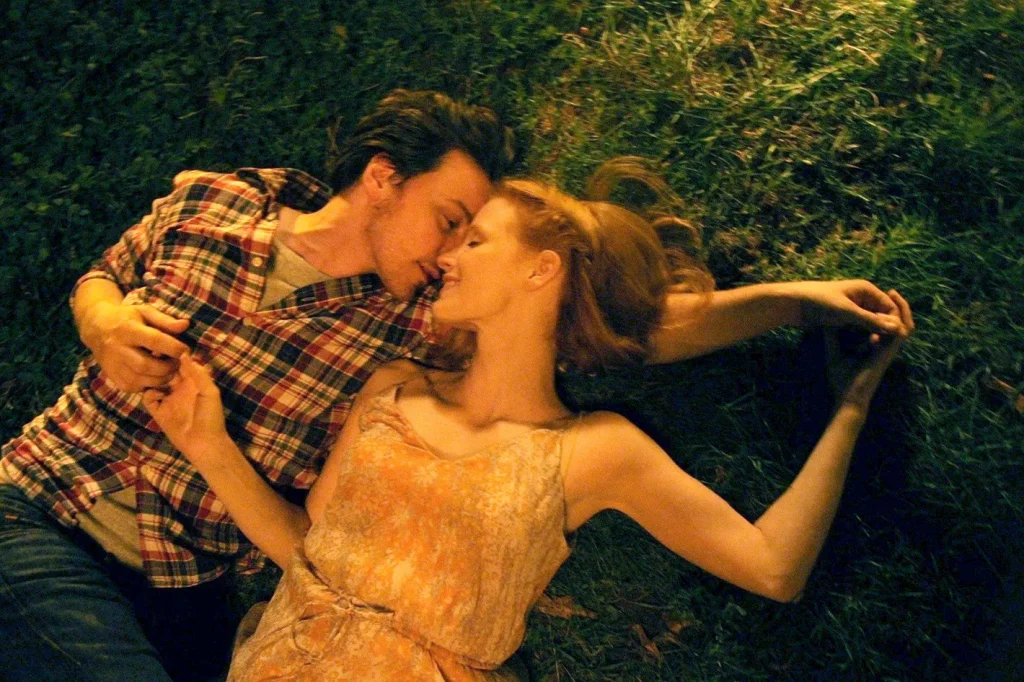
The modern relationship movie has more and more become an attempt to acknowledge that any relationship story has two subjective sides, which must be told. In Hans Canosa’s Conversations with Other Women, the film finds objectivity through a split screen that ensures a camera is on both its characters at all times: it’s a different movie if you watch only Helena Bonham Carter throughout than if you keep your eyes fixed on Aaron Eckhart. Richard Linklater’s brilliant Before Midnight keeps its objectivity by ensuring both Jesse and Celine are always in frame at the same time, which produces a similar effect as Canosa’s film, while keeping the characters more connected. Writer-director Ned Benson’s two-part feature film debut, The Disappearance of Eleanor Rigby: Him and Her, which had its world premiere at the Toronto International Film Festival this year, aims not for objectivity but to tell the very subjective story of the unraveling of a relationship in two separate films, one from his perspective and one from hers.
Him follows Conor (James McAvoy) as he watches in bewilderment when his wife, Eleanor (Jessica Chastain), attempts suicide and leaves him. He spends the film trying to find her, to talk things out, and get closure, completely oblivious to why she has left and where she has gone. Eleanor appears as somewhat of a mystery because Conor is clueless: her depression seems to him to come out of nowhere, as does her departure, and whenever she returns to him, he can’t quite pinpoint her motivations.
Although Him and Her are quite stylistically different, the stories they each tell are similar. The scenes when both characters are present are not told entirely differently, though Conor and Eleanor may have highlighted different parts of the scenes. The films open with the couple dining and dashing, running into Central Park, and collapsing in a moment of passion. Conor’s memory focusses on the excitement of the chase and the eroticism of their exchange, while Eleanor’s account skips over much of this and stays with the sweet and tender exchanges they have, in conversation and cuddling. In a later scene, Conor’s infidelity comes out, and in “Him” he confesses and takes responsibility, while in Her, she figures it out herself and states it with no objections from him. It is in these scenes that the two versions seen together are strongest, because when watching Him, an attempt at sex post-breakup may seem like a farewell gesture on Eleanor’s part, but in Her, we see the context of what she’s been going through and how it is actually an attempt to rekindle their lost romance.
Our understanding of the couple’s interactions is helped by being privy to what each of them experiences separately. In Him, he spends time with his father and friends, and at his failing restaurant, and we watch him flail. In Her, we see the bits of Eleanor’s life that Conor missed: getting picked up from the hospital post suicide attempt, moving back in with her parents, interacting with her sister and nephew, and trying to start fresh by taking classes at the university where she meets an important mentor (Viola Davis). Part of Conor’s bewilderment at Eleanor’s motivations is because he simply wasn’t present during pivotal events in her life.
In the Q&A after the film, Benson explained that he wrote Her first, specifically for Jessica Chastain, a long-time friend, and then decided to write the other half, afterwards, and it shows. Her is smart and nuanced, rich in character and emotion, and with fewer self-conscious references that feel stilted and unreal: more is shown rather than told. In some ways, Him feels like an add-on, the characters less fully realised in script, though the acting is irreproachable. Him is often clunky with characters over-explaining or scenes going on too long. Her would work as a standalone film, but “Him” is mostly interesting for how it connects to Her.
Benson intended for the films to be viewed in either order, and at TIFF they were screened together in both orders. I saw The Disappearance of Eleanor Rigby: Him first, which is part of what made “Her” a richer experience — just filling in the gaps. Had the two films not been screened together, I’m not sure I would have been willing to go back to the cinema again to see The Disappearance of Eleanor Rigby: Her, and relationship movies are my genre. Seeing them together is essential, but they are three hours combined, which may be longer than was really necessary, as Him especially could have been significantly trimmed.
The Disappearance of Eleanor Rigby: Him and Her attributes the breakdown of their relationship to the different ways in which they deal with their two-month-old’s death: he wants to forget and move on, but she wants to start over again as someone else. While this motivation is believable, there is little in the films to explain why these characters would deal with tragedy in such different ways, which makes the child’s death feel more like a plot device to break them up than an inevitable cause of their breakup. It’s also why the endings of both films are ambiguous, suggesting seemingly different possible futures, without having necessarily earned this ambiguity. But as a concept, these retellings of the same story from two perspectives is a brilliant idea, and it’s executed thoughtfully. While these films were flawed, Benson’s next film could be a revision to reach perfection.

